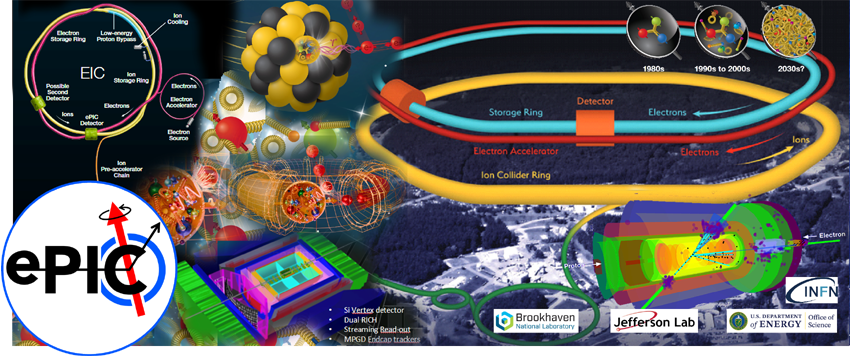
ePIC, understanding the nuclear glue holding matter together in the Universe.
The Electron Proton-Ion Collider (ePIC) experiment is a next-generation accelerator in construction built at the Brookhaven National Laboratory (BNL) in Upton, New York, USA (EIC). It is planned for collisions between polarized electrons and protons or heavy nuclei, which are also polarized. The ePIC experiment, scheduled to be commissioned in 2030, involves, at present, more than 850 scientists from more than 292 institutions in 40 nations. It will allow a detailed investigation of the internal structure of protons and neutrons, and the interactions of quarks and gluons, that are the fundamental constituents of visible matter in the universe, with unprecedented precision..
In addition to a complete understanding of the nuclear force and the proton and neutron structure, ePIC will open studies on the contribution of quarks and gluons to the properties of nucleons (their mass, spin and radius), on the density of gluons in nuclei and its possible saturation, which would create a kind of new form of matter, and on the formation of hadrons from quarks and gluons in nuclear matter (a process that goes by the name of hadronization). Diffusion processes between polarized electrons and ions (from hydrogen to lead, with the lightest being polarized) with center-of-mass energies ranging from 40 to 120 GeV, will be investigated through very intense beams.

INFN is participating with about a hundred researchers and technicians and16 sections and laboratories. It is responsible for the participation to the Silicon Vertex Detector, based on Micro Resistive Well Detector (muRwell) technology, responsible of the Ring-imaging Cherenkov detector (RICH) construction, the Micro Pattern Gaseous Detectors (MPDG) terminal trackers and the read-out electronics and data flow.
The INFN Rome Tor Vergata group is working on detectors, simulations and events reconstruction, and on the development of front-end electronics boards. In particular, the group coordinates the project of MPGD trackers, while is completing the test-beam data analysis of the muRwell and of the detector reaction to tilted and curved tracks, its initial design and engineering tests. This experimental initiative began in 2019 under the initiative EIC-NET, now merged into ePIC.













































































































